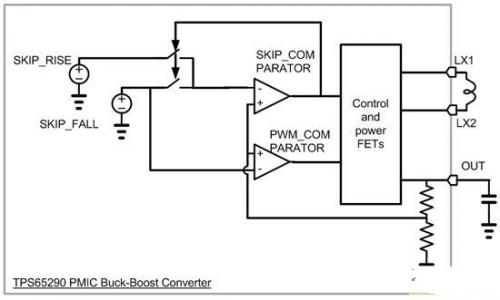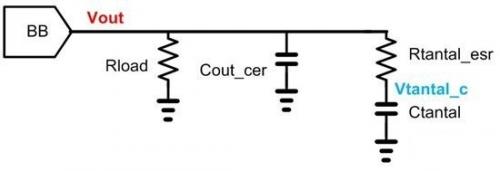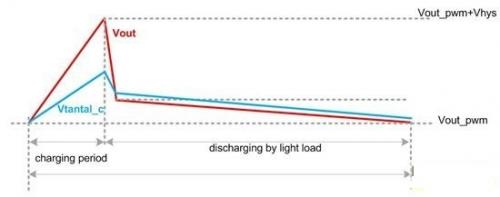How to Select Output Filter Capacitors in Efficient Pulse Frequency Hopping Mode
Time:2023-04-19
Views:1067
Pulse frequency hopping mode (PSM) is a widely used method to improve light load efficiency. We will take the TPS65290 device with PSM mode as an example to introduce how to select an output filter capacitor. Figures 1 and 2 show the simplified block diagram and output waveform of TPS65290 in PSM mode, respectively.




As shown in Figure 1, in PSM mode, only SKIP_ COMPARATOR participated in the feedback loop. If the output voltage drops to the lowest value (Vout_pwm in Figure 2), the buck converter will turn on and charge the output capacitor to the highest value (Vout_pwm+Vhys in Figure 2). Once the output voltage reaches the highest value, the converter begins to enter a sleep state until the light load discharge causes the output voltage to drop to the lowest value again.
Due to the converter being in a sleep state during discharge, the efficiency of light load operation in PSM mode may be improved compared to normal pulse width modulation (PWM) mode. If the discharge process becomes longer (meaning the load is lighter), then the efficiency advantage of PSM over PWM will become more apparent.

Figure 1. Simplified block diagram of TPS65290 in PSM mode

Figure 2. Simplified output waveform of DC-DC converter in PSM mode
However, PSM mode can also deviate from the ideal waveform, and improper selection of output capacitors can also reduce efficiency.
I have a client who has encountered a problem where the system board efficiency is lower than expected. The customer wishes to achieve excellent stability, therefore limiting the maximum capacitance of ceramic capacitors. To achieve the desired stability, the customer uses tantalum capacitors to compensate for the remaining capacitance. In this way, they added a large capacitance tantalum capacitor with high equivalent series resistance (ESR) on the system board and connected it in parallel with a low ESR small capacitance ceramic capacitor (as shown in Figure 3).

Figure 3. Improper selection of output capacitor in PSM mode
If the tantalum capacitor is much larger than the ceramic capacitor, the output waveform of PSM will become the situation shown in Figure 4.

Figure 4. Output waveform obtained using the output capacitor selection scheme in Figure 3
The red and blue lines represent the output voltage and the pure capacitance voltage of tantalum capacitors, respectively. The ESR and capacitance of tantalum capacitors are relatively large, which means that their response speed is slower than that of ceramic capacitors. Therefore, during the charging stage, the output voltage of the ceramic capacitor is maximized by quickly charging it, but the pure capacitor voltage of the tantalum capacitor has not yet reached its maximum value.
If the DC-DC converter begins to enter a sleep state, the charges stored in the ceramic capacitor will be transferred to the tantalum capacitor and load. Therefore, this charge transfer from ceramic capacitors to tantalum capacitors will cause a rapid decrease in output voltage and also lead to a shorter discharge time. As the discharge time decreases, the efficiency advantage of PSM mode will also decrease.
In order to achieve the expected high efficiency in PSM mode, the capacitance of high ESR capacitors should be significantly smaller than that of low ESR ceramic capacitors.
|
Disclaimer: This article is transferred from other platforms and does not represent the views and positions of this site. If there is any infringement or objection, please contact us to delete it. thank you! |











